A Look At Triple-GPU Performance And Multi-GPU Scaling, Part 1
by Ryan Smith on April 3, 2011 7:00 AM ESTCiv V, Battlefield, STALKER, and DIRT 2
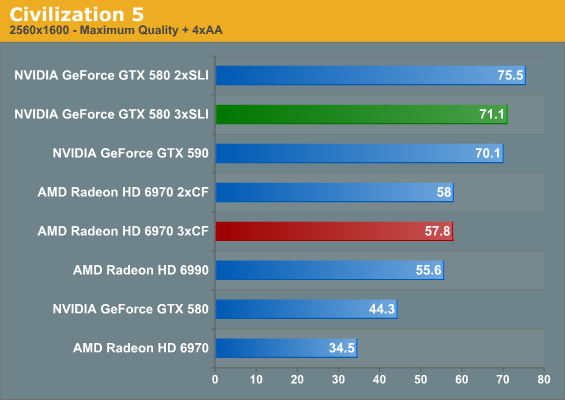
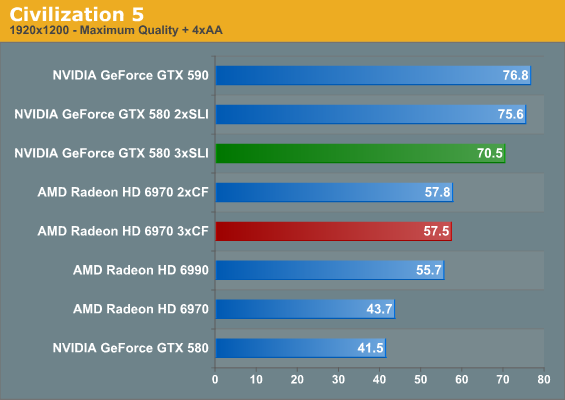
Civilization V continues to be the oddball among our benchmarks. Having started out as a title with low framerates and poor multi-GPU scaling, in recent months AMD and NVIDIA have rectified this some. As a result it’s now possible to crack 60fps at 2560 with a pair of high-end GPUs, albeit with some difficulty. In our experience Civ V is a hybrid bottlenecked game – we have every reason to believe it’s bottlenecked by the CPU at certain points, but the disparity between NVIDIA and AMD’s performance indicates there’s a big difference in how the two are settings things up under the hood.
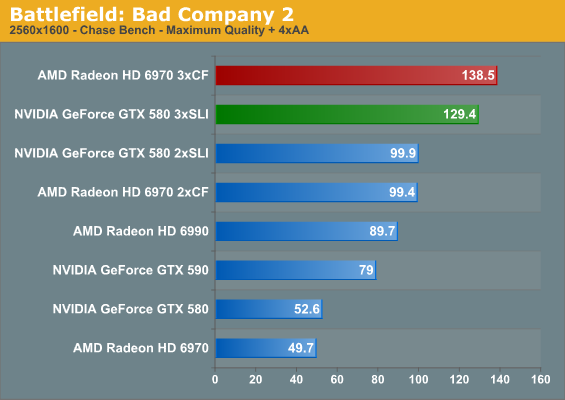
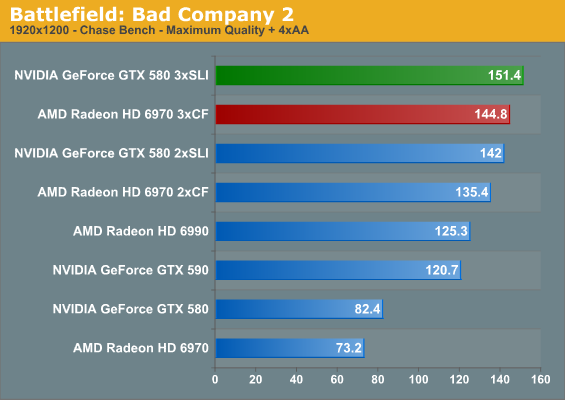
When we started using Bad Company 2 a year ago, it was actually a rather demanding benchmark; anything above 60fps at 2560 required SLI/CF. Today that’s still true, but at 52fps the GTX 580 comes close to closing that gap. On the flip side two GPUs can send scores quite a distance up, and three GPUs will push that over 120fps. Now if we could just get a 120Hz 2560 monitor…
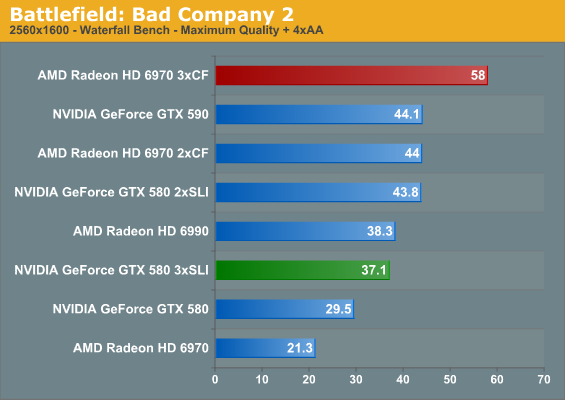
The Bad Company 2 Waterfall benchmark is our other minimum framerate benchmark, as it provides very consistent results. NVIDIA normally does well here with one GPU, but with two GPUs the gap closes to the point where NVIDIA may be CPU limited as indicated by our 580SLI/590 scores. At three GPUs AMD falls just short of a 60fps minimum, while the triple GTX 580 setup drops in performance. This would indicate uneven performance scaling for NVIDIA with three GPUs.
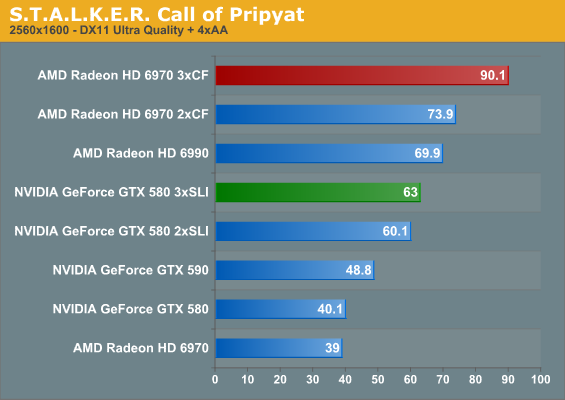

STALKER is another title that is both shader heavy and potentially VRAM-intensive. When moving from 1GB cards to 2GB cards we’ve seen the average framerate climb a respectable amount, which may be why AMD does so well here with multiple GPUs given the 512MB advantage in VRAM. With three GPUs the GTX 580 can crack 60fps, but the 6970 can clear 90fps.
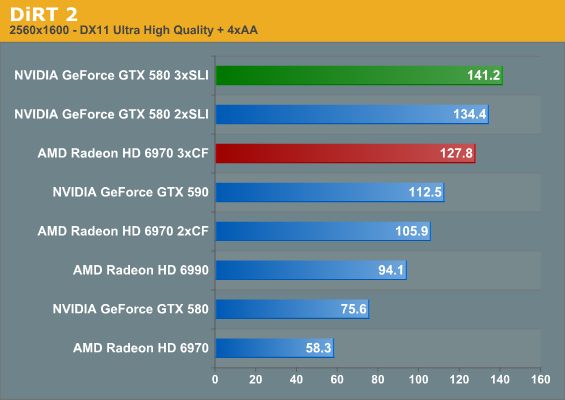
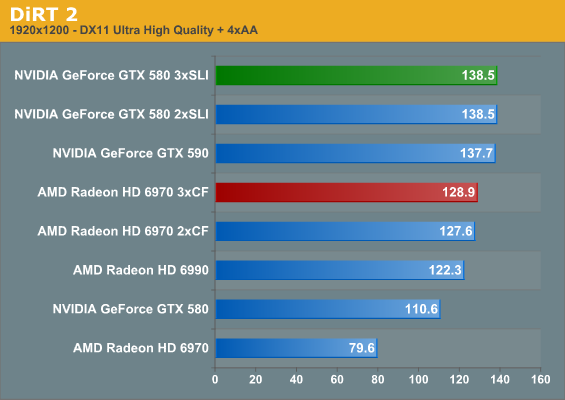
We’ve seen DiRT 2 become CPU limited with two GPUs at 1920, so it shouldn’t come as a surprise that with three GPUs a similar thing happens at 2560. Although we can never be 100% sure that we’re CPU limited versus just seeing poor scaling, the fact that our framerates top out at only a few FPS above our top 1920 scores is a solid sign of this.
| Radeon HD 6970 | GeForce GTX 580 | |||||
| GPUs | 1->2 | 2->3 | 1->3 | 1->2 | 2->3 | 1->3 |
| Civilization V | 168% | 99% | 167% | 170% | 95% | 160% |
| Battlefield: BC2 Chase | 200% | 139% | 278% | 189% | 129% | 246% |
| Battlefield: BC2 Water | 206% | 131% | 272% | 148% | 85% | 125% |
| STALKER: CoP | 189% | 121% | 231% | 149% | 104% | 157% |
| DiRT 2 | 181% | 120% | 219% | 177% | 105% | 186% |
So what does multi-GPU scaling look like in this batch of games? The numbers favor AMD at this point, particularly thanks to STALKER. Throwing out a CPU limited DIRT 2, and the average FPS for an AMD card moving from one GPU to two GPUs is 185%; NVIDIA’s gains under the same circumstances are only 169%.
For the case of two GPUs, AMD’s worst showing is Civilization V at 168%, while for NVIDIA it’s STALKER at %149. In the case of Civilization V the close gains to NVIDIA (168% vs. 170%) hides the fact that the GTX 580 already starts out at a much better framerate, so while the gains are similar the final performance is not. STALKER meanwhile presents us with an interesting case where the GTX 580 and Radeon HD 6970 start out close and end up far apart; AMD has the scaling and performance advantage thanks to NVIDIA’s limited performance gains here.
As for scaling with three GPUs, as was the case with two GPUs the results are in AMD’s favor. We still see some weak scaling at times – or none as in the case of Civilization V – but AMD’s average gain of 120% over a dual-GPU configuration isn’t too bad. NVIDIA’s average gains are basically only half AMD’s though at 110%, owing to an even larger performance loss in Civilization V, and almost no gain in STALKER. Battlefield: Bad Company 2 is the only title that NVIDIA sees significant gains in, and while the specter of CPU limits always looms overhead, I’m not sure what’s going on in STALKER for NVIDIA; perhaps we’re looking at the limits of 1.5GB of VRAM?
Looking at minimum framerates though the Battlefield: Bad Company 2, the situation is strongly in AMD’s favor for both two and three GPUs, as AMD scales practically perfectly with two GPUs and relatively well with three GPUs. I strongly believe this has more to do with the game than the technology, but at the end of the day NVIDIA’s poor triple-GPU scaling under this benchmark really puts a damper on things.










97 Comments
View All Comments
masterchi - Sunday, April 3, 2011 - link
"Going from 1 GPU to 2 GPUs also gives AMD a minor advantage, with the average gain being 182% for NVIDIA versus 186% for AMD"This should be 78.6 and 87.7, respectively.
Ryan Smith - Sunday, April 3, 2011 - link
To be clear, there I'm only including the average FPS (and not the min FPS) of all the games except HAWX (CPU limited). Performance is as the numbers indicate, 182% and 186% of a single card's performance respectively.eddman - Sunday, April 3, 2011 - link
Doesn't make sense. Are you saying that, for example, 580 SLI is 2.77 times faster than a single 580?SagaciousFoo - Sunday, April 3, 2011 - link
Think of it this way: A single 580 card is 100% performance. Two cards equals 186% performance. So the SLI setup is 14% shy of being 2x the performance of a single card.AnnihilatorX - Sunday, April 3, 2011 - link
This is typical percentile jargon. It's author's miss really.When you say 186% average gain, you mean 2.86 times the performance.
When you say 86% average gain, you mean 186% the performance, and that's what you mean.
The keyword gain there ais unecessary and misleading.
80% increase -> x 1.8
180% increase -> x 2.8
SlyNine - Sunday, April 3, 2011 - link
Correct, it should read, 186% of (multiplication) a single card.But I am making the assumption that gain means addition.
DaFox - Sunday, April 3, 2011 - link
That's unfortunately how it works when it come to multi GPU scaling. Ryan is just continuing the standard trend set by everyone else in the industry.Bremen7000 - Sunday, April 3, 2011 - link
No, he's just using misleading wording. The chart should either read "Performance: 186%" or "Performance gain: 86%", etc. This isn't hard.sigmatau - Monday, April 4, 2011 - link
The OP is correct. You cannot use "gain" and include the 100% of the first card. This is simple percentages.If I have one gallon of gas in my car and add one gallon, I gain 100%.
I also have a total of 200% of what I had at the start.
Kaboose - Sunday, April 3, 2011 - link
Finally, it has taken awhile but finally and thank you!!! Multi-monitor is exactly what we need in these reviews, especially the 6990 and 590 reviews.